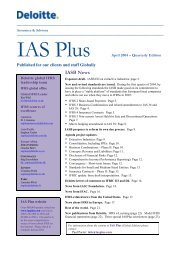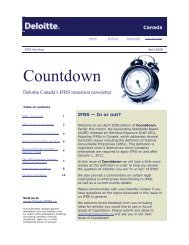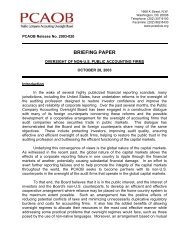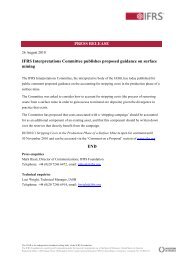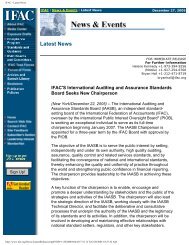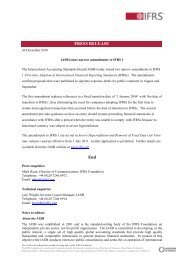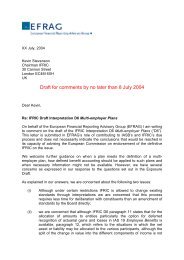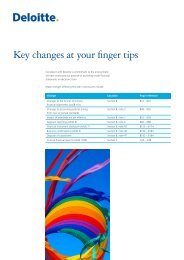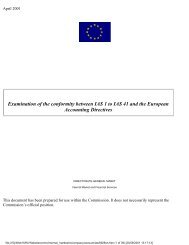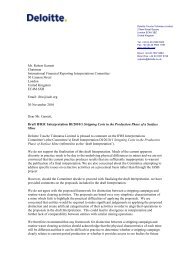Revised Standards on Financial Instruments - IAS Plus
Revised Standards on Financial Instruments - IAS Plus
Revised Standards on Financial Instruments - IAS Plus
You also want an ePaper? Increase the reach of your titles
YUMPU automatically turns print PDFs into web optimized ePapers that Google loves.
Published for our clients and staff throughout the world<br />
DELOITTE TOUCHE TO<br />
February 2004<br />
Special Editi<strong>on</strong><br />
DELOITTE TOUCHE<br />
TOHMATSU GLOBAL <strong>IAS</strong><br />
LEADERSHIP TEAM<br />
<strong>IAS</strong> GLOBAL OFFICE<br />
Global <strong>IAS</strong> Leader:<br />
Ken Wild,<br />
kwild@deloitte.co.uk<br />
<strong>IAS</strong> CENTRES OF<br />
EXCELLENCE<br />
Americas:<br />
D. J. Gann<strong>on</strong>,<br />
iasplusamericas@<br />
deloitte.com<br />
Asia-Pacific:<br />
Stephen Taylor,<br />
iasplus@deloitte.com.hk<br />
Europe-Africa:<br />
JOHANNESBURG –<br />
Graeme Berry,<br />
iasplus@deloitte.co.za<br />
COPENHAGEN –<br />
Stig Enevoldsen,<br />
dk_iasplus@deloitte.dk<br />
LONDON –<br />
Ver<strong>on</strong>ica Poole,<br />
iasplus@deloitte.co.uk<br />
PARIS –<br />
Laurence Rivat,<br />
iasplus@deloitte.fr<br />
<strong>IAS</strong> PLUS WEB SITE<br />
Over 480,000 people visited our<br />
www.iasplus.com web site in<br />
2003 (compared to 267,000 in<br />
2002 and 89,000 in 2001). Our<br />
goal is to be the most<br />
comprehensive source of news<br />
about IFRS <strong>on</strong> the Internet.<br />
Please check in regularly during<br />
2004.<br />
<str<strong>on</strong>g>Revised</str<strong>on</strong>g> <str<strong>on</strong>g>Standards</str<strong>on</strong>g> <strong>on</strong> <strong>Financial</strong> <strong>Instruments</strong><br />
In December 2003, the <strong>IAS</strong>B issued revised versi<strong>on</strong>s of <strong>IAS</strong> 32 <strong>Financial</strong><br />
<strong>Instruments</strong>: Disclosure and Presentati<strong>on</strong> and <strong>IAS</strong> 39 <strong>Financial</strong> <strong>Instruments</strong>:<br />
Recogniti<strong>on</strong> and Measurement. Both standards are effective for annual<br />
periods beginning <strong>on</strong> or after 1 January 2005, and both supersede the<br />
previous versi<strong>on</strong>s of the two standards. Earlier applicati<strong>on</strong> of the revised<br />
standards together, but not individually, is permitted.<br />
There remains <strong>on</strong>e outstanding area that has not been included in the two<br />
revised standards. An exposure draft <strong>on</strong> Fair Value Hedge Accounting for a<br />
Portfolio Hedge of Interest Rate Risk, comm<strong>on</strong>ly referred to as ‘macro<br />
hedging’, was issued in August 2003. The <strong>IAS</strong>B is currently c<strong>on</strong>sidering the<br />
views of the resp<strong>on</strong>dents to that exposure draft, with a plan to issue a<br />
supplement to the revised <strong>IAS</strong> 39 by the end of the first quarter of 2004.<br />
Under the European Uni<strong>on</strong>’s <strong>IAS</strong> Regulati<strong>on</strong>, European listed companies<br />
must use <strong>IAS</strong>B standards in their c<strong>on</strong>solidated financial statements starting in<br />
2005. Because <strong>IAS</strong>s 32 and 39 were being significantly revised, the<br />
endorsement of these standards by the European Commissi<strong>on</strong> was delayed<br />
when the other <strong>IAS</strong>s were endorsed in September 2003. Now that both of<br />
those standards have been issued, the EU is in a positi<strong>on</strong> to endorse them<br />
(though c<strong>on</strong>siderati<strong>on</strong> might await completi<strong>on</strong> of the macro hedging<br />
comp<strong>on</strong>ent). We recommend that EU listed companies should c<strong>on</strong>tinue with<br />
their preparati<strong>on</strong>s assuming that both the standards will be endorsed for use in<br />
2005.<br />
Scope<br />
<strong>IAS</strong>s 32 and 39 should be applied to all types of financial instruments unless<br />
scoped out from <strong>on</strong>e or both of the <str<strong>on</strong>g>Standards</str<strong>on</strong>g>.<br />
The following financial instruments are, according to specific provisi<strong>on</strong>s,<br />
scoped out of both revised <strong>IAS</strong> 32 and <strong>IAS</strong> 39:<br />
q interests in subsidiaries, associates, and joint ventures accounted for<br />
under <strong>IAS</strong> 27, <strong>IAS</strong> 28, or <strong>IAS</strong> 31; however <strong>IAS</strong>s 32 and 39 apply in cases<br />
where under <strong>IAS</strong> 27, <strong>IAS</strong> 28, or <strong>IAS</strong> 31 such interests are to be<br />
accounted for under <strong>IAS</strong> 39 – for example, derivatives <strong>on</strong> an interest in a<br />
subsidiary, associate, or joint venture;<br />
q employers’ rights and obligati<strong>on</strong>s under employee benefit plans to which<br />
<strong>IAS</strong> 19 applies;<br />
q c<strong>on</strong>tracts for c<strong>on</strong>tingent c<strong>on</strong>siderati<strong>on</strong> in a business combinati<strong>on</strong>;<br />
q c<strong>on</strong>tracts requiring payment based <strong>on</strong> climatic, geological, or other<br />
physical variable, except derivatives embedded in such c<strong>on</strong>tracts are<br />
subject to <strong>IAS</strong> 39;<br />
q rights and obligati<strong>on</strong>s under insurance c<strong>on</strong>tracts, except <strong>IAS</strong> 39 does<br />
apply to financial instruments that take the form of an insurance (or<br />
reinsurance) c<strong>on</strong>tract but that principally involve the transfer of financial<br />
risks and derivatives embedded in insurance c<strong>on</strong>tracts.<br />
In additi<strong>on</strong>, <strong>IAS</strong> 39 does not apply to financial instruments that meet the<br />
definiti<strong>on</strong> of own equity under <strong>IAS</strong> 32.<br />
© 2004 Deloitte Touche Tohmatsu<br />
All rights reserved.<br />
______________________________________________________________________________<br />
1 February 2004
Scope, c<strong>on</strong>tinued<br />
<strong>IAS</strong> 39 includes expanded criteria<br />
for the determining whether<br />
c<strong>on</strong>tracts to buy or sell n<strong>on</strong>financial<br />
items are within its scope<br />
Definiti<strong>on</strong> now includes those<br />
c<strong>on</strong>tracts indexed to or settled in<br />
an entity’s own equity instruments<br />
that do not meet the definiti<strong>on</strong> of<br />
equity.<br />
Leases<br />
<strong>IAS</strong> 32 applies to lease receivables and payables. <strong>IAS</strong> 39 applies to those<br />
financial instruments <strong>on</strong>ly in limited respects:<br />
q It applies to lease receivables with respect to the derecogniti<strong>on</strong> and<br />
impairment provisi<strong>on</strong>s.<br />
q It applies to lease payables with respect to the derecogniti<strong>on</strong> provisi<strong>on</strong>s.<br />
<strong>IAS</strong> 39 applies to derivatives embedded in leases.<br />
<strong>Financial</strong> guarantees<br />
<strong>IAS</strong> 32 applies to all financial guarantees.<br />
Guarantees that provide for payments to be made in resp<strong>on</strong>se to changes in a<br />
specified variable (price, rate, or index) are derivatives within the scope of<br />
<strong>IAS</strong> 39.<br />
Guarantees are <strong>on</strong>ly excluded from <strong>IAS</strong> 39 if they provide for specified<br />
payments to be made to reimburse the holder for a loss it incurs because a<br />
specified debtor fails to make payment when due.<br />
Loan commitments<br />
<strong>IAS</strong> 32 applies to all loan commitments.<br />
Loan commitments are outside the scope of <strong>IAS</strong> 39 if they cannot be settled<br />
net in cash or another financial instrument, they are not designated as<br />
financial liabilities at fair value through profit or loss, and the entity does not<br />
have a past practice of selling the loans that resulted from the commitment<br />
shortly after originati<strong>on</strong>.<br />
C<strong>on</strong>tracts to buy or sell n<strong>on</strong>-financial items<br />
C<strong>on</strong>tracts to buy or sell n<strong>on</strong>-financial items are within the scope of <strong>IAS</strong>s 32<br />
and 39 if they can be settled net in cash or another financial asset and are not<br />
entered into and held for the purpose of the receipt or delivery of a n<strong>on</strong>financial<br />
item in accordance with the entity’s expected purchase, sale, or<br />
usage requirements.<br />
Definiti<strong>on</strong> of a <strong>Financial</strong> Asset<br />
Previously, <strong>IAS</strong> 32 defined a financial asset as cash, a c<strong>on</strong>tractual right to<br />
receive cash or another financial asset, a c<strong>on</strong>tractual right to exchange<br />
financial assets or liabilities with another entity under c<strong>on</strong>diti<strong>on</strong>s that are<br />
potentially favourable, or an equity instrument of another entity.<br />
The definiti<strong>on</strong> now includes those c<strong>on</strong>tracts where an entity uses its own<br />
equity instruments ‘as currency’ in a c<strong>on</strong>tract to receive or deliver a variable<br />
number of shares whose value equals a fixed amount or an amount based <strong>on</strong><br />
changes in an underlying variable.<br />
A c<strong>on</strong>tract that will or may be settled in the entity’s own equity instruments is<br />
a financial asset if it is:<br />
q a n<strong>on</strong>-derivative for which the entity is or may be obliged to receive a<br />
variable number of its own equity instruments; or<br />
q a derivative that will or may be settled other than by the exchange of a<br />
fixed amount of cash or another financial asset for a fixed number of the<br />
entity’s own equity instruments. For this purpose the entity’s own equity<br />
instruments do not include instruments that are themselves c<strong>on</strong>tracts for<br />
the future receipt or delivery of the entity’s own equity instruments.<br />
______________________________________________________________________________<br />
2 February 2004
Any financial asset can now be<br />
designated <strong>on</strong> initial recogniti<strong>on</strong> as<br />
<strong>on</strong>e to be measured at fair value<br />
through profit or loss.<br />
The opti<strong>on</strong> to record gains and<br />
losses <strong>on</strong> AFS assets directly in<br />
profit or loss has been removed, as<br />
the opti<strong>on</strong> to designate any<br />
financial asset at fair value<br />
through profit or loss is<br />
introduced.<br />
An entity is now permitted to<br />
classify in ‘loans and receivables’<br />
loans that are purchased, provided<br />
they are not quoted in an active<br />
market.<br />
Any financial liability can now be<br />
designated <strong>on</strong> initial recogniti<strong>on</strong> as<br />
<strong>on</strong>e to be measured at fair value<br />
through profit or loss<br />
Classificati<strong>on</strong> of <strong>Financial</strong> Assets<br />
<strong>IAS</strong> 39 requires financial assets to be classified in <strong>on</strong>e of the following<br />
categories:<br />
q <strong>Financial</strong> assets at fair value through profit or loss.<br />
q Available-for-sale financial assets.<br />
q Loans and receivables.<br />
q Held-to-maturity investments.<br />
Those categories are used to determine how a particular financial asset is<br />
recognised and measured in the financial statements.<br />
<strong>Financial</strong> assets at fair value through profit or loss. This category has two<br />
subcategories. The first includes any financial asset that is designated <strong>on</strong><br />
initial recogniti<strong>on</strong> as <strong>on</strong>e to be measured at fair value with fair value changes<br />
in profit or loss. The sec<strong>on</strong>d category includes financial assets that are held<br />
for trading. All derivatives (except those designated hedging instruments)<br />
and financial assets acquired or held for the purpose of selling in the short<br />
term or for which there is a recent pattern of short-term profit taking are held<br />
for trading.<br />
Available-for-sale financial assets (AFS) are any n<strong>on</strong>-derivative financial<br />
assets designated <strong>on</strong> initial recogniti<strong>on</strong> as available for sale. AFS assets are<br />
measured at fair value in the balance sheet. Fair value changes <strong>on</strong> AFS assets<br />
are recognised directly in equity, through the statement of changes in equity,<br />
except for interest <strong>on</strong> AFS assets (which is recognised in income <strong>on</strong> an<br />
effective yield basis), impairment losses, and foreign exchange gains or<br />
losses. The cumulative gain or loss that was recognised in equity is<br />
recognised in profit or loss when an available-for-sale financial asset is<br />
derecognised.<br />
Loans and receivables are n<strong>on</strong>-derivative financial assets with fixed or<br />
determinable payments, originated or acquired, that are not quoted in an<br />
active market, not held for trading, and not designated <strong>on</strong> initial recogniti<strong>on</strong><br />
as assets at fair value through profit or loss or as available-for-sale. Loans<br />
and receivables for which the holder may not recover substantially all of its<br />
initial investment, other than because of credit deteriorati<strong>on</strong>, should be<br />
classified as available -for-sale. Loans and receivables are measured at<br />
amortised cost.<br />
Held-to-maturity investments are n<strong>on</strong>-derivative financial assets with fixed<br />
or determinable payments that an entity intends and is able to hold to maturity<br />
and that do not meet the definiti<strong>on</strong> of loans and receivables and are not<br />
designated <strong>on</strong> initial recogniti<strong>on</strong> as assets at fair value through profit or loss<br />
or as available for sale. Held-to-maturity investments are measured at<br />
amortised cost.<br />
If an entity sells a held -to-maturity investment other than in insignificant<br />
amounts or as a c<strong>on</strong>sequence of a n<strong>on</strong>-recurring, isolated event bey<strong>on</strong>d its<br />
c<strong>on</strong>trol that could not be reas<strong>on</strong>ably anticipated, all of its other held-tomaturity<br />
investments must be reclassified as available-for-sale for the current<br />
and next two financial reporting years.<br />
Definiti<strong>on</strong> of a <strong>Financial</strong> Liability<br />
A financial liability is any liability that is:<br />
q a c<strong>on</strong>tractual obligati<strong>on</strong> to deliver cash or another financial asset to<br />
another entity, or to exchange financial assets or financial liabilities with<br />
another entity under c<strong>on</strong>diti<strong>on</strong>s that are potentially unfavourable, or<br />
q a c<strong>on</strong>tract that will or may be settled in the entity’s own equity<br />
instruments where the c<strong>on</strong>tract is either a n<strong>on</strong>-derivative for which the<br />
entity may have to deliver a variable number of own equity instruments,<br />
or a derivative that will be settled other than by exchange of a fixed<br />
amount of a financial asset for a fixed number of own equity instruments.<br />
______________________________________________________________________________<br />
3 February 2004
The alternative method for the<br />
measurement of the equity and<br />
liability comp<strong>on</strong>ents of a<br />
compound instrument<br />
(apporti<strong>on</strong>ment of proceeds based<br />
<strong>on</strong> relative fair values of the two<br />
comp<strong>on</strong>ents) has been removed<br />
Classificati<strong>on</strong> of <strong>Financial</strong> Liabilities<br />
<strong>IAS</strong> 39 recognises two classes of financial liabilities:<br />
q <strong>Financial</strong> liabilit ies at fair value through profit or loss.<br />
q Other financial liabilities measured at amortised cost using the effective<br />
interest method.<br />
A financial liability at fair value through profit or loss is either:<br />
q a financial liability classified as held for trading; or<br />
q a financial liability that is designated by the entity as a liability at fair<br />
value through profit or loss up<strong>on</strong> initial recogniti<strong>on</strong>.<br />
Classificati<strong>on</strong> as debt or equity<br />
The fundamental principle of <strong>IAS</strong> 32 is that an instrument should be<br />
classified as either a liability or an equity instrument according to its<br />
substance based <strong>on</strong> the definiti<strong>on</strong>s of a financial liability and an equity<br />
instrument, and not according to its legal form.<br />
<strong>IAS</strong> 32 defines an equity instrument as any c<strong>on</strong>tract that evidences a residual<br />
interest in the assets of an entity after deducting all of its liabilities.<br />
A financial liability is defined above. Based <strong>on</strong> the definiti<strong>on</strong>, the following<br />
instruments are financial liabilities of the issuer:<br />
q A financial instrument that provides for mandatory redempti<strong>on</strong> by the<br />
issuer or gives the holder the right to require the issuer to redeem the<br />
instrument (such as mandatorily redeemable preferred shares).<br />
q A financial instrument that gives the holder the right to put that<br />
instrument back to the issuer for cash or another financial asset.<br />
q An instrument where the choice of settlement in cash or another financial<br />
asset is c<strong>on</strong>tingent <strong>on</strong> the outcome of circumstances bey<strong>on</strong>d the c<strong>on</strong>trol<br />
of both the issuer and the holder.<br />
Derivatives <strong>on</strong> own shares<br />
A derivative c<strong>on</strong>tract that will be settled by the entity receiving or delivering<br />
a fixed number of its own equity instruments in exchange for a fixed amount<br />
of cash or another financial asset is an equity instrument. A derivative <strong>on</strong><br />
own equity that gives the issuer or the holder a choice over how it is settled,<br />
such as settlement net in cash or net in shares, is a financial asset or liability<br />
unless all of the settlement alternatives would result in equity classificati<strong>on</strong>.<br />
Compound financial instruments<br />
In the case of compound financial instruments, which have both a liability<br />
and equity comp<strong>on</strong>ent, such comp<strong>on</strong>ent parts are required to be split with<br />
each part accounted for and presented separately according to its substance.<br />
<strong>IAS</strong> 32 requires the issuer’s liability <strong>on</strong> a compound instrument, such as a<br />
c<strong>on</strong>vertible b<strong>on</strong>d, to be recorded initially at fair value, with the residual value<br />
to be assigned to the equity comp<strong>on</strong>ent.<br />
Interest, dividends, losses, and gains<br />
Interest, dividends, losses, and gains relating to a financial liability are to be<br />
recognised as income or expense in profit or loss. Distributi<strong>on</strong>s to holders of<br />
equity instruments as well as transacti<strong>on</strong> costs for an equity transacti<strong>on</strong> (other<br />
than costs of issuing an equity instrument that are directly attributable to the<br />
acquisiti<strong>on</strong> of a business) are to be accounted for within equity.<br />
Treasury shares<br />
If an entity reacquires its own shares (with these being held by the entity or<br />
another member of the c<strong>on</strong>solidated group), the cost of those instruments is to<br />
be deducted from equity.<br />
No gain or loss is to be recorded in profit or loss <strong>on</strong> the purchase, sale, issue,<br />
or cancellati<strong>on</strong> of an entity’s own equity instruments.<br />
______________________________________________________________________________<br />
4 February 2004
On initial recogniti<strong>on</strong>, a financial<br />
instrument should be measured at<br />
fair value. A gain or loss should<br />
not be immediately recognised<br />
unless there is evidence of<br />
observable market data supporting<br />
a fair value different to the<br />
c<strong>on</strong>siderati<strong>on</strong> paid or received.<br />
Impairment losses are recognised<br />
as incurred – it is not appropriate<br />
to recognise, in advance, expected<br />
future losses.<br />
Measurement<br />
Initially, financial assets and liabilities should be measured at fair value<br />
(including transacti<strong>on</strong> costs, for assets and liabilities not measured at fair<br />
value through profit or loss).<br />
Subsequently, financial assets and liabilities (including derivatives) should be<br />
measured at fair value, with the following excepti<strong>on</strong>s:<br />
q Loans and receivables, held-to-maturity investments, and n<strong>on</strong>-derivative<br />
financial liabilities should be measured at amortised cost using the<br />
effective interest method.<br />
q Investments in equity investments with no reliable fair value<br />
measurement (and related derivatives) should be measured at cost.<br />
q <strong>Financial</strong> assets and liabilities that are designated as a hedged item or<br />
hedging instrument are subject to measurement under the hedge<br />
accounting requirements of the <strong>IAS</strong> 39.<br />
q <strong>Financial</strong> liabilities that arise when a transfer of a financial asset does not<br />
qualify for derecogniti<strong>on</strong>, or that are accounted for using the c<strong>on</strong>tinuinginvolvement<br />
method, are subject to particular measurement requirements.<br />
Fair value is the amount for which an asset could be exchanged, or a liability<br />
settled, between knowledgeable, willing parties in an arm’s length<br />
transacti<strong>on</strong>. <strong>IAS</strong> 39 provides a hierarchy to be used in determining the fair<br />
value for a financial instrument:<br />
q Quoted market prices in an active market are the best evidence of fair<br />
value and should be used, where they exist, to measure the financial<br />
instrument.<br />
q If a market for a financial instrument is not active, an entity establishes<br />
fair value by using a valuati<strong>on</strong> technique that makes maximum use of<br />
market inputs and includes recent arm’s length market transacti<strong>on</strong>s,<br />
reference to the current fair value of another instrument that is<br />
substantially the same, discounted cash flow analysis, and opti<strong>on</strong> pricing<br />
models. An acceptable valuati<strong>on</strong> technique incorporates all factors that<br />
market participants would c<strong>on</strong>sider in setting a price and is c<strong>on</strong>sistent<br />
with accepted ec<strong>on</strong>omic methodologies for pricing financial instruments.<br />
q If there is no active market for an equity instrument and the range of<br />
reas<strong>on</strong>able fair values is significant and these estimates cannot be made<br />
reliably, then an entity must measure the equity instrument at cost less<br />
impairment.<br />
Amortised cost is calculated using the effective interest method. The<br />
effective interest rate is the rate that exactly discounts estimated future cash<br />
payments or receipts through the expected life of the financial instrument to<br />
the net carrying amount of the financial asset or liability.<br />
<strong>Financial</strong> assets that are not carried at fair value though profit and loss are<br />
subject to an impairment test.<br />
A financial asset or group of assets is impaired and impairment losses are<br />
incurred <strong>on</strong>ly if there is objective evidence as a result of <strong>on</strong>e or more events<br />
that occurred after the initial recogniti<strong>on</strong> of the asset.<br />
The amount of the loss is measured as the difference between the asset’s<br />
carrying amount and the present value of estimated cash flows discounted at<br />
the financial asset’s original effective interest rate.<br />
Individual assets that are individually assessed and for which no impairment<br />
exists are grouped with financial assets with similar credit risk statistics and<br />
collectively assessed for impairment.<br />
______________________________________________________________________________<br />
5 February 2004
Recogniti<strong>on</strong> and Derecogniti<strong>on</strong><br />
In determining whether an asset<br />
qualifies for derecogniti<strong>on</strong>, the<br />
evaluati<strong>on</strong> of the transfer of the<br />
risks and rewards inherent in the<br />
asset takes priority over the<br />
assessment as to whether c<strong>on</strong>trol<br />
over that asset has been passed or<br />
not.<br />
Initial recogniti<strong>on</strong><br />
<strong>IAS</strong> 39 requires recogniti<strong>on</strong> of a financial asset or a financial liability when,<br />
and <strong>on</strong>ly when, the entity becomes a party to the c<strong>on</strong>tractual provisi<strong>on</strong>s of the<br />
instrument, subject to the following provisi<strong>on</strong>s in respect of regular way<br />
purchases.<br />
Regular way purchases or sales of a financial asset<br />
A regular way purchase or sale of financial assets is recognised and<br />
derecognised using either trade date or settlement date accounting. The<br />
method used is to be applied c<strong>on</strong>sistently for all purchases and sales of<br />
financial assets that bel<strong>on</strong>g to the same category of financial asset as defined<br />
in <strong>IAS</strong> 39 (note that for this purpose assets held for trading form a different<br />
category from assets designated at fair value through profit or loss). The<br />
choice of method is an accounting policy.<br />
Derecogniti<strong>on</strong> of a financial asset<br />
The basic premise for the derecogniti<strong>on</strong> model in <strong>IAS</strong> 39 is to determine<br />
whether the asset under c<strong>on</strong>siderati<strong>on</strong> for derecogniti<strong>on</strong> is:<br />
q an asset in its entirety; or<br />
q specifically identified cash flows from an asset; or<br />
q a fully proporti<strong>on</strong>ate share of the cash flows from an asset; or<br />
q a fully proporti<strong>on</strong>ate share of specifically identified cash flows from a<br />
financial asset.<br />
Once the asset under c<strong>on</strong>siderati<strong>on</strong> for derecogniti<strong>on</strong> has been determined, an<br />
assessment is made as to whether the asset has been transferred, and if so,<br />
whether the transfer of that asset is subsequently eligible for derecogniti<strong>on</strong>.<br />
An asset is transferred if either the entity has transferred the c<strong>on</strong>tractual rights<br />
to receive the cash flows, or the entity has retained the c<strong>on</strong>tractual rights to<br />
receive the cash flows from the asset, but has assumed a c<strong>on</strong>tractual<br />
obligati<strong>on</strong> to pass those cash flows <strong>on</strong> under an arrangement that meets the<br />
following three c<strong>on</strong>diti<strong>on</strong>s:<br />
q the entity has no obligati<strong>on</strong> to pay amounts to the eventual recipient<br />
unless it collects equivalent amounts <strong>on</strong> the original asset,<br />
q the entity is prohibited from selling or pledging the original asset (other<br />
than as security to the eventual recipient), and<br />
q the entity has an obligati<strong>on</strong> to remit those cash flows without material<br />
delay.<br />
Once an entity has determined that the asset has been transferred, it then<br />
determines whether or not it has transferred substantially all of the risks and<br />
rewards of ownership of the asset. If substantially all the risks and rewards<br />
have been transferred, the asset is derecognised. If substantially all the risks<br />
and rewards have been retained, derecogniti<strong>on</strong> of the asset is precluded.<br />
If the entity has neither retained nor transferred substantially all of the risks<br />
and rewards of the asset, then the entity must assess whether it has<br />
relinquished c<strong>on</strong>trol of the asset or not. If the entity does not c<strong>on</strong>trol the asset<br />
then derecogniti<strong>on</strong> is appropriate; however if the entity has retained c<strong>on</strong>trol of<br />
the asset, then the entity c<strong>on</strong>tinues to recognise the asset to the extent to<br />
which it has a c<strong>on</strong>tinuing involvement in the asset.<br />
These various derecogniti<strong>on</strong> steps are summarised below in a decisi<strong>on</strong> tree.<br />
______________________________________________________________________________<br />
6 February 2004
C<strong>on</strong>solidate all subsidiaries (including any SPE) Paragraph 15<br />
Determine whether the derecogniti<strong>on</strong> principles below are<br />
applied to a part or all of an asset (or group of similar assets)<br />
Have the rights to the cash<br />
flows from the asset expired?<br />
Yes<br />
Derecognise the asset<br />
No<br />
Has the entity transferred<br />
its rights to receive the cash<br />
flows from the asset?<br />
No<br />
Has the entity assumed an<br />
obligati<strong>on</strong> to pay the cash flows<br />
from the asset?<br />
No<br />
C<strong>on</strong>tinue to recognise the asset<br />
Yes<br />
Has the entity transferred<br />
substantially all risks and rewards?<br />
Yes<br />
Derecognise the asset<br />
No<br />
Has the entity retained<br />
substantially all risks and rewards?<br />
Yes<br />
C<strong>on</strong>tinue to recognise the asset<br />
No<br />
Has the entity retained<br />
c<strong>on</strong>trol of the asset?<br />
No<br />
Derecognise the asset<br />
Yes<br />
C<strong>on</strong>tinue to recognise the asset to the<br />
extent of the entity’s c<strong>on</strong>tinuing involvement<br />
Derecogniti<strong>on</strong> of a financial liability<br />
A financial liability should be removed from the balance sheet when, and<br />
<strong>on</strong>ly when, it is extinguished, that is, when the obligati<strong>on</strong> specified in the<br />
c<strong>on</strong>tract is either discharged, cancelled, or expired.<br />
Where there has been an exchange between an existing borrower and lender<br />
of debt instruments with substantially different terms, or there has been a<br />
substantial modificati<strong>on</strong> of the terms of an existing financial liability, this<br />
transacti<strong>on</strong> is accounted for as an extinguishment of the original financial<br />
liability and the recogniti<strong>on</strong> of a new financial liability. A gain or loss from<br />
extinguishment of the original financial liability is recognised in the income<br />
statement.<br />
Derivatives<br />
<strong>IAS</strong> 39 defines a derivative as a financial instrument or other c<strong>on</strong>tract within<br />
the scope of the standard:<br />
q whose value changes in resp<strong>on</strong>se to an underlying;<br />
q that requires no initial investment, or <strong>on</strong>e that is smaller than would be<br />
required for a c<strong>on</strong>tract with similar resp<strong>on</strong>se to changes in market<br />
factors; and<br />
q that is settled at a future date.<br />
______________________________________________________________________________<br />
7 February 2004
Derivatives, c<strong>on</strong>tinued<br />
Whilst the principle has not<br />
changed, clarificati<strong>on</strong> has been<br />
added <strong>on</strong> when a c<strong>on</strong>tract is net<br />
settled.<br />
C<strong>on</strong>tracts to buy or sell financial items are always within the scope of <strong>IAS</strong> 39.<br />
C<strong>on</strong>tracts to buy or sell n<strong>on</strong>-financial items are outside the scope of <strong>IAS</strong> 39 if<br />
they were entered into and c<strong>on</strong>tinue to be held for the purpose of the receipt<br />
or delivery of n<strong>on</strong>-financial items in accordance with the entity’s expected<br />
purchase, sale, or usage requirements; otherwise they are within the scope.<br />
C<strong>on</strong>tracts to buy or sell n<strong>on</strong>-financial items are inside the scope if net<br />
settlement occurs. The following situati<strong>on</strong>s c<strong>on</strong>stitute net settlement:<br />
q the terms of the c<strong>on</strong>tract permit either counterparty to settle net;<br />
q there is a past practice of net settling similar c<strong>on</strong>tracts;<br />
q there is a past practice, for similar c<strong>on</strong>tracts, of taking delivery of the<br />
underlying and selling it within a short period after delivery to generate a<br />
profit from short-term fluctuati<strong>on</strong>s in price, or from a dealer’s margin; or<br />
q the n<strong>on</strong>-financial item is readily c<strong>on</strong>vertible to cash.<br />
Derivatives must always be recognised at fair value <strong>on</strong> the balance sheet.<br />
Unless the derivative is a hedging instrument in a cash flow or net investment<br />
hedge, changes in fair value are recognised in the income statement.<br />
Embedded derivatives<br />
An embedded derivative is a feature within a c<strong>on</strong>tract, such that the cash<br />
flows associated with that feature behave in a similar fashi<strong>on</strong> to a stand-al<strong>on</strong>e<br />
derivative. In the same way that derivatives must be accounted for at fair<br />
value <strong>on</strong> the balance sheet with changes recognised in the income statement,<br />
so must some embedded derivatives. <strong>IAS</strong> 39 requires that an embedded<br />
derivative be separated from its host c<strong>on</strong>tract and accounted for as a<br />
derivative when:<br />
q the ec<strong>on</strong>omic risks and characteristics of the embedded derivative are not<br />
closely related to those of the host c<strong>on</strong>tract;<br />
q a separate instrument with the same terms as the embedded derivative<br />
would meet the definiti<strong>on</strong> of a derivative; and<br />
q the entire instrument is not measured at fair value with changes in fair<br />
value recognised in the income statement.<br />
If an embedded derivative is separated, the host c<strong>on</strong>tract is accounted for<br />
under the appropriate standard (for instance, under <strong>IAS</strong> 39 if the host is a<br />
financial instrument). Appendix A to <strong>IAS</strong> 39 provides examples of<br />
embedded derivatives that are closely related to their hosts, and of those that<br />
are not. Examples of embedded derivatives that are not closely related to<br />
their hosts (and therefore must be separately accounted for) include:<br />
q the equity c<strong>on</strong>versi<strong>on</strong> opti<strong>on</strong> in debt c<strong>on</strong>vertible to ordinary shares (from<br />
the perspective of the holder <strong>on</strong>ly);<br />
q commodity indexed interest or principal payments in host debt c<strong>on</strong>tracts;<br />
q cap and floor opti<strong>on</strong>s in host debt c<strong>on</strong>tracts that are in-the-m<strong>on</strong>ey when<br />
the instrument was issued;<br />
q leveraged inflati<strong>on</strong> adjustments to lease payments;<br />
q currency derivatives in purchase or sale c<strong>on</strong>tracts for n<strong>on</strong>-financial items<br />
where the foreign currency is not that of either counterparty to the<br />
c<strong>on</strong>tract, is not the currency in which the related good or service is<br />
routinely denominated in commercial transacti<strong>on</strong>s around the world, and<br />
is not the currency that is comm<strong>on</strong>ly used in such c<strong>on</strong>tracts in the<br />
ec<strong>on</strong>omic envir<strong>on</strong>ment in which the transacti<strong>on</strong> takes place.<br />
______________________________________________________________________________<br />
8 February 2004
Hedge Accounting<br />
<strong>IAS</strong> 39 permits hedge accounting under certain circumstances provided that<br />
the hedging relati<strong>on</strong>ship is:<br />
q formally designated and documented, including the entity’s risk<br />
management objective and strategy for undertaking the hedge,<br />
identificati<strong>on</strong> of the hedging instrument, the hedged item, the nature of<br />
the risk being hedged, and how the entity will assess the hedging<br />
instrument’s effectiveness; and<br />
q expected to be highly effective in achieving offsetting changes in fair<br />
value or cash flows attributable to the hedged risk as designated and<br />
documented, and effectiveness can be reliably measured.<br />
Hedging instruments<br />
All derivative c<strong>on</strong>tracts with an external counterparty may be designated as<br />
hedging instruments except for some written opti<strong>on</strong>s.<br />
An external n<strong>on</strong>-derivative financial asset or liability may not be designated<br />
as a hedging instrument except as a hedge of foreign currency risk.<br />
A proporti<strong>on</strong> of the hedging instrument may be designated as the hedging<br />
instrument. Generally, specific cash flows inherent in a derivative cannot be<br />
designated in a hedge relati<strong>on</strong>ship while other cash flows are excluded.<br />
However, the intrinsic value and the time value of an opti<strong>on</strong> c<strong>on</strong>tract may be<br />
separated, with <strong>on</strong>ly the intrinsic value being designated. Similarly, the<br />
interest element and the spot price of a forward can also be separated, with<br />
the spot price being the designated risk.<br />
Hedged items<br />
A hedged item can be:<br />
q a single recognised asset or liability, firm commitment, highly probable<br />
transacti<strong>on</strong>, or a net investment in a foreign operati<strong>on</strong>;<br />
q a group of assets, liabilities, firm commitments, highly probable forecast<br />
transacti<strong>on</strong>s, or net investments in foreign operati<strong>on</strong>s with similar risk<br />
characteristics;<br />
q a held-to-maturity investment for foreign currency or credit risk (but not<br />
for interest risk or prepayment risk);<br />
q a porti<strong>on</strong> of the cash flows or fair value of a financial asset or financial<br />
liability; or<br />
q a n<strong>on</strong>-financial item for foreign currency risk <strong>on</strong>ly or the risk of changes<br />
in fair value of the entire item.<br />
Hedge accounting is not permitted for hedges of a net positi<strong>on</strong>, that is, the net<br />
of a financial asset and financial liability (though the macro hedging exposure<br />
draft menti<strong>on</strong>ed <strong>on</strong> page 1 would change this). However it is possible to<br />
designate in a hedging relati<strong>on</strong>ship a porti<strong>on</strong> of the gross assets or liabilities,<br />
or forecast cash flows that give rise to the net exposure, provided the hedge<br />
meets the other hedge accounting criteria.<br />
A hedge of the foreign currency risk of a firm commitment may be accounted<br />
for as a fair value hedge or as a cash flow hedge.<br />
Effectiveness<br />
<strong>IAS</strong> 39 requires hedge effectiveness to be assessed both prospectively and<br />
retrospectively. A hedge is regarded as highly effective if, at incepti<strong>on</strong> and,<br />
at a minimum, at each reporting date, the changes in the fair value or cash<br />
flows of the hedged item attributable to the hedged risk are expected to be<br />
almost fully offset by the changes in the fair value or cash flows of the<br />
hedging instrument <strong>on</strong> a prospective basis, and <strong>on</strong> a retrospective basis where<br />
actual results are within a range of 80% to 125%.<br />
All hedge ineffectiveness is recognised immediately in the income statement.<br />
______________________________________________________________________________<br />
9 February 2004
Hedge Accounting, c<strong>on</strong>tinued<br />
Hedges of firm commitments are<br />
now fair value hedges, except that<br />
the FX risk comp<strong>on</strong>ent of the<br />
commitment may be designated a<br />
cash flow hedge<br />
Entities have a choice of whether<br />
to apply basis adjustment for<br />
hedges of forecast transacti<strong>on</strong>s<br />
resulting in the recogniti<strong>on</strong> of a<br />
n<strong>on</strong>-financial asset or liability<br />
Categories of hedges<br />
A fair value hedge is a hedge of the exposure to changes in fair value of a<br />
recognised asset or liability or a previously unrecognised firm commitment to<br />
buy or sell an asset at a fixed price or an identified porti<strong>on</strong> of such an asset,<br />
liability or firm commitment, that is attributable to a particular risk and could<br />
affect profit or loss. The gain or loss from the change in fair value of the<br />
hedging instrument is recognised immediately in profit or loss. At the same<br />
time the carrying amount of the hedged item is adjusted for the corresp<strong>on</strong>ding<br />
gain or loss with respect to the hedged risk, which is also recognised<br />
immediately in net profit or loss.<br />
A cash flow hedge is a hedge of the exposure to variability in cash flows that<br />
(i) is attributable to a particular risk associated with a recognised asset or<br />
liability (such as all or some future interest payments <strong>on</strong> variable rate debt) or<br />
a highly probable forecast transacti<strong>on</strong> and (ii) could affect profit or loss.<br />
The porti<strong>on</strong> of the gain or loss <strong>on</strong> the hedging instrument that is determined to<br />
be an effective hedge is recognised directly in equity and recycled to the<br />
income statement when the hedged cash transacti<strong>on</strong> affects profit or loss.<br />
If the hedged cash flows result in the recogniti<strong>on</strong> of a n<strong>on</strong>-financial asset or<br />
liability, the entity can choose to adjust the basis of the asset or liability for<br />
the amount deferred in equity. This opti<strong>on</strong> has the status of an accounting<br />
policy and must be applied c<strong>on</strong>sistently to all such hedges.<br />
A hedge of a net investment in a foreign operati<strong>on</strong> as defined in <strong>IAS</strong> 21 is<br />
accounted for similarly to a cash flow hedge.<br />
Disc<strong>on</strong>tinuati<strong>on</strong> of hedge accounting<br />
Hedge accounting must be disc<strong>on</strong>tinued prospectively if:<br />
q the hedging instrument expires or is sold, terminated, or exercised;<br />
q the hedge no l<strong>on</strong>ger meets the hedge accounting criteria – for example it<br />
is no l<strong>on</strong>ger effective;<br />
q for cash flow hedges the forecast transacti<strong>on</strong> is no l<strong>on</strong>ger expected to<br />
occur; or<br />
q the entity revokes the hedge designati<strong>on</strong>.<br />
If hedge accounting ceases for a cash flow hedge relati<strong>on</strong>ship because the<br />
forecast transacti<strong>on</strong> is no l<strong>on</strong>ger expected to occur, gains and losses deferred<br />
in equity must be taken to the income statement immediately. If the<br />
transacti<strong>on</strong> is still expected to occur and the hedge relati<strong>on</strong>ship ceases, the<br />
amounts accumulated in equity will be retained in equity until the hedged<br />
item affects profit or loss.<br />
If a hedged financial instrument that is measured at amortised cost has been<br />
adjusted for the gain or loss attributable to the hedged risk in a fair value<br />
hedge, from the mo ment the hedge relati<strong>on</strong>ship is disc<strong>on</strong>tinued, this<br />
adjustment is amortised to profit or loss based <strong>on</strong> a recalculated effective<br />
interest rate <strong>on</strong> this date such that the adjustment is fully amortised by the<br />
maturity of the instrument.<br />
Offsetting a financial asset and financial liability<br />
Offsetting of a financial asset and financial liability is appropriate <strong>on</strong>ly when<br />
the entity:<br />
q currently has a legally enforceable right to set off the recognised<br />
amounts; and<br />
q intends to either settle <strong>on</strong> a net basis or to realise the asset and settle the<br />
liability simultaneously.<br />
______________________________________________________________________________<br />
10 February 2004
Designati<strong>on</strong> of own debt as a<br />
liability at fair value through profit<br />
and loss is now permitted, but<br />
disclosure is required of (a) the<br />
change in fair value not<br />
attributable to changes in the<br />
benchmark interest rate and (b)<br />
the difference between the carrying<br />
amount and the amount<br />
c<strong>on</strong>tractually due <strong>on</strong> maturity.<br />
Disclosure<br />
The standard requires a descripti<strong>on</strong> of the entity’s financial risk management<br />
objectives and policies including its hedging policies.<br />
For each class of financial instrument an entity must disclose:<br />
q informati<strong>on</strong> about extent and nature of instruments including significant<br />
terms; and<br />
q accounting policies and methods adopted, including recogniti<strong>on</strong> criteria<br />
and measurement principles<br />
In additi<strong>on</strong>, for each class of financial asset or financial liability, an entity<br />
must disclose:<br />
q specified informati<strong>on</strong> regarding exposure to interest rate risk and credit<br />
risk;<br />
q fair value of that class, except in the case of unquoted equity investments<br />
or derivatives linked to such equity investments that are measured at cost<br />
under <strong>IAS</strong> 39 because their fair value cannot be measured reliably (in<br />
which case further specified disclosures are necessary); and<br />
q specified informati<strong>on</strong> about the methods and significant assumpti<strong>on</strong>s<br />
applied in determining fair values, including informati<strong>on</strong> relating to the<br />
use of quoted market prices and valuati<strong>on</strong> techniques.<br />
Other disclosure requirements include:<br />
q in respect of all hedges: a descripti<strong>on</strong> of the hedge and a descripti<strong>on</strong> of<br />
the financial instrument designated as the hedging instrument and the<br />
nature of the risk being hedged;<br />
q additi<strong>on</strong>al disclosures about cash flow hedges;<br />
q details of transfers of financial assets where the entity c<strong>on</strong>tinues to<br />
recognise all of the asset or c<strong>on</strong>tinues to recognise the asset to the extent<br />
of the entity’s c<strong>on</strong>tinuing involvement;<br />
q carrying amount of financial assets accepted or pledged as collateral;<br />
q existence of any multiple embedded derivative features in issued<br />
compound financial instruments;<br />
q for financial assets and financial liabilities carried at fair value through<br />
profit or loss, the amount of the change in fair value not attributable to<br />
changes in the benchmark interest rate and the difference between the<br />
carrying amount and amount c<strong>on</strong>tractually due <strong>on</strong> maturity;<br />
q reas<strong>on</strong>s for any reclassificati<strong>on</strong> of financial assets from measurement at<br />
fair value to measurement at cost;<br />
q material items of income, expense, and gains and losses resulting from<br />
financial assets or financial liabilities whether recognised in profit or loss<br />
or in equity;<br />
q nature and amount of any impairment losses recognised;<br />
q defaults and breaches in relati<strong>on</strong> to loan agreements.<br />
______________________________________________________________________________<br />
11 February 2004
First-time adopters of IFRS in<br />
2005 are not required to restate<br />
their 2004 comparatives to comply<br />
with <strong>IAS</strong>s 32 and 39<br />
Many of the transiti<strong>on</strong>al provisi<strong>on</strong>s<br />
represent amendments to IFRS 1<br />
First-time Adopti<strong>on</strong> of IFRS<br />
Transiti<strong>on</strong> and Effective Date (<strong>IAS</strong> 39)<br />
Comparative financial statements<br />
In 2005 financial statements <strong>on</strong>ly, an entity may elect for the prior-year<br />
comparative informati<strong>on</strong> to still be prepared under their existing GAAP. If<br />
this electi<strong>on</strong> is taken the entity must:<br />
q disclose this fact together with the basis used to prepare this informati<strong>on</strong>;<br />
and<br />
q disclose the nature of the main adjustments that would make the<br />
informati<strong>on</strong> comply with <strong>IAS</strong> 32 and <strong>IAS</strong> 39. The entity need not<br />
quantify those adjustments. However, the entity must treat any<br />
adjustment between the balance sheet at the comparative period’s<br />
reporting date and the balance sheet at the start of the first IFRS reporting<br />
period as arising from a change in accounting policy.<br />
Effective date<br />
<strong>IAS</strong> 39 must be applied for annual periods beginning <strong>on</strong> or after 1 January<br />
2005. Earlier applicati<strong>on</strong> is permitted <strong>on</strong>ly if the entity also early applies <strong>IAS</strong><br />
32. If the entity early adopts the two standards that fact should be disclosed.<br />
Transiti<strong>on</strong><br />
On initial adopti<strong>on</strong>, subject to the guidance below, <strong>IAS</strong> 39 should be applied<br />
retrospectively, with the opening balance of retained earnings for the earliest<br />
period presented and all other comparative amounts adjusted as if the<br />
standard had always been in use, except where restating the informati<strong>on</strong><br />
would be impracticable, in which case the entity must disclose that fact and<br />
indicate the extent to which the informati<strong>on</strong> was restated.<br />
Derecogniti<strong>on</strong><br />
With respect to derecogniti<strong>on</strong> the entity may either apply the <strong>IAS</strong> 39<br />
requirements prospectively, or apply the <strong>IAS</strong> 39 requirements retrospectively<br />
from a date of the entity’s choosing, provided that the informati<strong>on</strong> needed to<br />
apply <strong>IAS</strong> 39 to assets and liabilities derecognised as a result of past<br />
transacti<strong>on</strong>s was obtained at the time of initially accounting for those<br />
transacti<strong>on</strong>s.<br />
Designati<strong>on</strong> up<strong>on</strong> transiti<strong>on</strong><br />
On initial adopti<strong>on</strong> of the standard an entity may designate a previously<br />
recognised financial asset or financial liability as a financial asset or financial<br />
liability at fair value through profit or loss or as available for sale.<br />
Hedging<br />
If, before the date of transiti<strong>on</strong> to IFRSs, an entity had designated a<br />
transacti<strong>on</strong> as a hedge, but the hedge does not meet the c<strong>on</strong>diti<strong>on</strong>s for hedge<br />
accounting in <strong>IAS</strong> 39, the entity must apply the rules <strong>on</strong> disc<strong>on</strong>tinuati<strong>on</strong> of<br />
hedge accounting. Transacti<strong>on</strong>s entered into before the date of transiti<strong>on</strong> to<br />
IFRSs may not be retrospectively designated as hedges.<br />
The designati<strong>on</strong> and documentati<strong>on</strong> of a hedge relati<strong>on</strong>ship must be<br />
completed <strong>on</strong> or before the date of transiti<strong>on</strong> to IFRSs if the hedge<br />
relati<strong>on</strong>ship is to qualify for hedge accounting from that date.<br />
______________________________________________________________________________<br />
12 February 2004
Transiti<strong>on</strong> and Effective Date, c<strong>on</strong>tinued<br />
Fair value hedges<br />
With respect to fair value hedges, if under previous GAAP the hedged item<br />
was not adjusted, the entity should adjust the carrying amount of the hedged<br />
item <strong>on</strong> transiti<strong>on</strong> with the adjustment amounting to the lower of:<br />
a. that porti<strong>on</strong> of the cumulative change in the fair value of the hedged item<br />
that reflects the designated hedged risk and that was not recognised under<br />
previous GAAP; and<br />
b. that porti<strong>on</strong> of the cumulative change in the fair value of the hedging<br />
instrument that reflects the designated hedged risk.<br />
Cash flow hedges<br />
Under its previous GAAP, an entity may have deferred gains and losses <strong>on</strong> a<br />
cash flow hedge of a forecast transacti<strong>on</strong>. If, at the date of transiti<strong>on</strong> to<br />
IFRSs, the hedged forecast transacti<strong>on</strong> is not highly probable, but is expected<br />
to occur, the entire deferred gain or loss is recognised in equity. Any net<br />
cumulative gain or loss that is reclassified to equity <strong>on</strong> initial applicati<strong>on</strong> of<br />
<strong>IAS</strong> 39 remains in equity until (a) the forecast transacti<strong>on</strong> subsequently<br />
results in the recogniti<strong>on</strong> of a n<strong>on</strong>-financial asset or n<strong>on</strong>-financial liability, (b)<br />
the forecast transacti<strong>on</strong> affects profit or loss, or (c) circumstances<br />
subsequently change and the forecast transacti<strong>on</strong> is no l<strong>on</strong>ger expected to<br />
occur, in which case any related net cumulative gain or loss that had been<br />
recognised directly in equity is recognised in profit or loss. If the hedging<br />
instrument is still held, but the hedge does not qualify as a cash flow hedge<br />
under <strong>IAS</strong> 39, hedge accounting is no l<strong>on</strong>ger appropriate starting from the<br />
date of transiti<strong>on</strong> to IFRSs.<br />
An entity may not adjust the carrying amount of n<strong>on</strong>-financial assets and n<strong>on</strong>financial<br />
liabilities to exclude gains and losses related to cash flow hedges<br />
that were included in the carrying amount before the beginning of the<br />
financial year in which <strong>IAS</strong> 39 is first applied.<br />
______________________________________________________________________________<br />
13 February 2004
ABOUT DELOITTE TOUCHE TOHMATSU<br />
Deloitte Touche Tohmatsu is an organisati<strong>on</strong> of member firms devoted to excellence in providing professi<strong>on</strong>al<br />
services and advice. We are focused <strong>on</strong> client service through a global strategy executed locally in nearly 150<br />
countries. With access to the deep intellectual capital of 120,000 people worldwide, our member firms (including<br />
their affiliates) deliver services in four professi<strong>on</strong>al areas: audit, tax, c<strong>on</strong>sulting and financia l advisory services. Our<br />
member firms serve over <strong>on</strong>e-half of the world’s largest companies, as well as large nati<strong>on</strong>al enterprises, public<br />
instituti<strong>on</strong>s, and successful, fast-growing global growth companies.<br />
Deloitte Touche Tohmatsu is a Swiss Verein (associati<strong>on</strong>), and, as such, neither Deloitte Touche Tohmatsu nor any<br />
of its member firms has any liability for each other’s acts or omissi<strong>on</strong>s. Each of the member firms is a separate and<br />
independent legal entity operating under the names “Deloitte”, “Deloitte & Touche”, “Deloitte Touche Tohmatsu”,<br />
or other related names. The services described herein are provided by the member firms and not by the Deloitte<br />
Touche Tohmatsu Verein. For regulatory and other reas<strong>on</strong>s certain member firms do not provide services in all four<br />
professi<strong>on</strong>al areas listed above.<br />
This newsletter has been written in general terms and is intended for general reference <strong>on</strong>ly. The applicati<strong>on</strong> of<br />
its c<strong>on</strong>tents to specific situati<strong>on</strong>s will depend <strong>on</strong> the particular circumstances involved. Accordingly, we<br />
recommend that readers seek appropriate professi<strong>on</strong>al advice regarding any particular problems they encounter.<br />
This newsletter should not be relied <strong>on</strong> as a substitute for such advice. The partners and managers of Deloitte<br />
Touche Tohmatsu will be pleased to advise <strong>on</strong> any such problems. While all reas<strong>on</strong>able care has been taken in<br />
the preparati<strong>on</strong> of this newsletter, no resp<strong>on</strong>sibility is accepted by Deloitte Touche Tohmatsu for any errors it<br />
might c<strong>on</strong>tain, or for any loss, howsoever caused, that happens to any pers<strong>on</strong> by their reliance <strong>on</strong> it.<br />
______________________________________________________________________________<br />
14 February 2004



